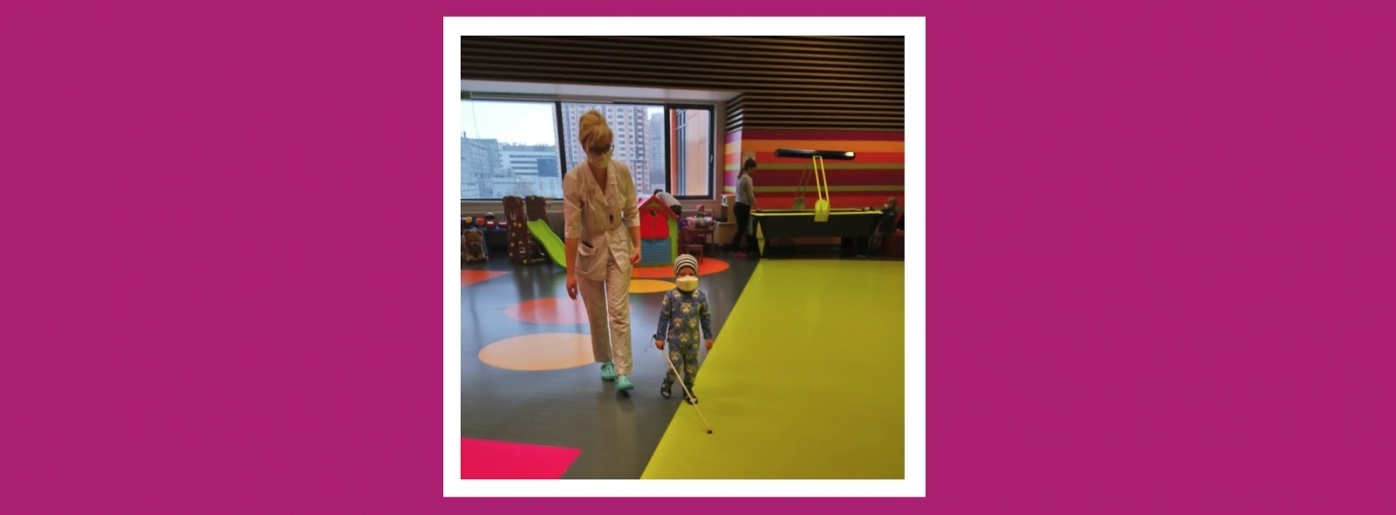Martha Lyubimova is a researcher at the Institute of Correctional Education of the Russian Academy of Education (RAE), typhlo-teacher (who teaches the visually impaired) and defectologist at the No.2 Moscow Special (Correctional) Secondary Boarding School. She speaks below about teaching small children how to move around on their own with the help of a white cane. You will learn from this article what to show to a blind child, how to show it, how to choose a cane and how not to discourage a child from using it.
My new friend Matvey was 2 years and 8 months old when we first met. He is a very active, interesting and smart child. Like all children of his age, he was a bit mischievous, wanted to run about, play and so on.
His mother, Ekaterina, was, obviously, worried about him getting around on his own so she supported my idea, with a lot of enthusiasm and interest, to teach Matvey to walk with a white cane independently.
Where do you begin teaching a preschool child the use of a white cane?
Firstly, it should be noted that independent movement of the visually impaired consists of two parts: the movement itself (where a white cane is used) and orientation. Orientation and movement (mobility) are equally important parts of a child’s independence. You should work on the development of these skills simultaneously and purposefully.
Audio description: This is a colour photo in a white frame against a pink background. There are light-coloured cupboards along a wall in a room. Marta Lyubimova is squatting near Matvey and is using her left hand to gently guide his left hand, which is holding a cane, with her right hand indicating the direction. On a cupboard door behind them, there are some photos of children. There is a worktop with a sink next to them.
How to choose a cane for a preschool child?
The cane’s length depends on the child’s height. A cane too short will be uncomfortable and unsafe since it will leave too little time for reaction, and a cane too long is hard to handle. To calculate the correct length of a cane, deduct 20cm from the child’s height. Otherwise, select a cane that fits under the child's armpit from the floor.
It is better to use a cane with a rolling tip such as “hemispherical” or “marshmallow”. A ball tip is not very suitable for young children: although it does not get caught in cracks in asphalt, tiling and other types of surfaces, its large diameter makes the cane too heavy.
What should you teach a preschool child?
A child should be taught to examine objects with the help of a tool. A cane serves as an extension of the hand. Anything that cannot be examined by hand can be examined with a cane. At first, every object and landmark en route should be examined by hand and then by a white cane during movement.
The techniques of handling a cane: the Diagonal and the simplified versions of the Two-Point Touch and Constant Contact techniques (read more about these techniques in the author’s future articles – ed.). The main thing is to teach the child to make an arc slightly wider than their shoulders while walking.
Detecting a material: During a walk or specially organised lesson, tap with the tip of the white cane the objects that you and your child come across and try to guess what they are made of and what they could be. To see if your guess is correct, examine the objects by hand.
Different surfaces. Use the white cane to study different surfaces indoors (parquet, tiles, carpet, linoleum) and outdoors (asphalt, ground, grass, cobblestones). Teach the child to react to changes in the surface.
Teach the child to react to obstacles in their way and to changes in the level of the surface in front of their feet. The child must stop if the white cane meets an obstacle (a wall, stairs, an object on the floor etc.) or “drops off” a kerb or stairs. After the child stops, show them what to do next.
Audio description: This is a colour photo in a white frame against a pink background. It is a room with a pink carpet on the floor. There are children’s drawings and a calendar on a multicoloured striped wall. Marta and Matvey are standing near a white vertical radiator, and there are two waste bins in front of them. Marta is leaning towards Matvey, who is holding a white cane. She is holding his right hand with her right hand. They are examining one of the bins with the cane.
When should a child be taught to use a cane?
For a preschool child, there is no need to use a white cane all the time, like visually impaired adults do. It is important to keep this practice in balance so that the child does not develop any negative emotions towards the use of a white cane.
Use the cane when the child is in a good mood. Depending on the tasks, suggest using a cane either in a familiar or unfamiliar surrounding space. For example, it is better to study materials and textures of surfaces in a familiar space while it is better to learn to detect and avoid obstacles, as well as react to them in a new place.
The main thing is to show the child why a white cane is needed, as well as support independence in the child as early as possible and show them that they can move around without anyone's help.
Make sure you praise the child for using a white cane, encourage them and be proud of them!
Our Matvey has been successfully completing all of the above tasks. Sometimes, he would protest and say: “That's it, I don’t want to walk with the white cane anymore!” We did not insist. Then the moment would arrive when he himself would ask: “Where is my white cane?”
We hope that soon there will be more visually impaired children who use a white cane!


